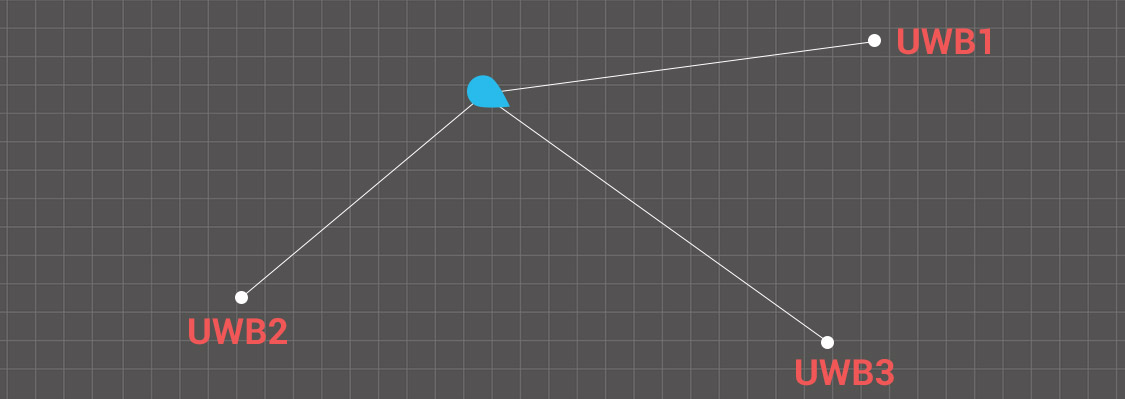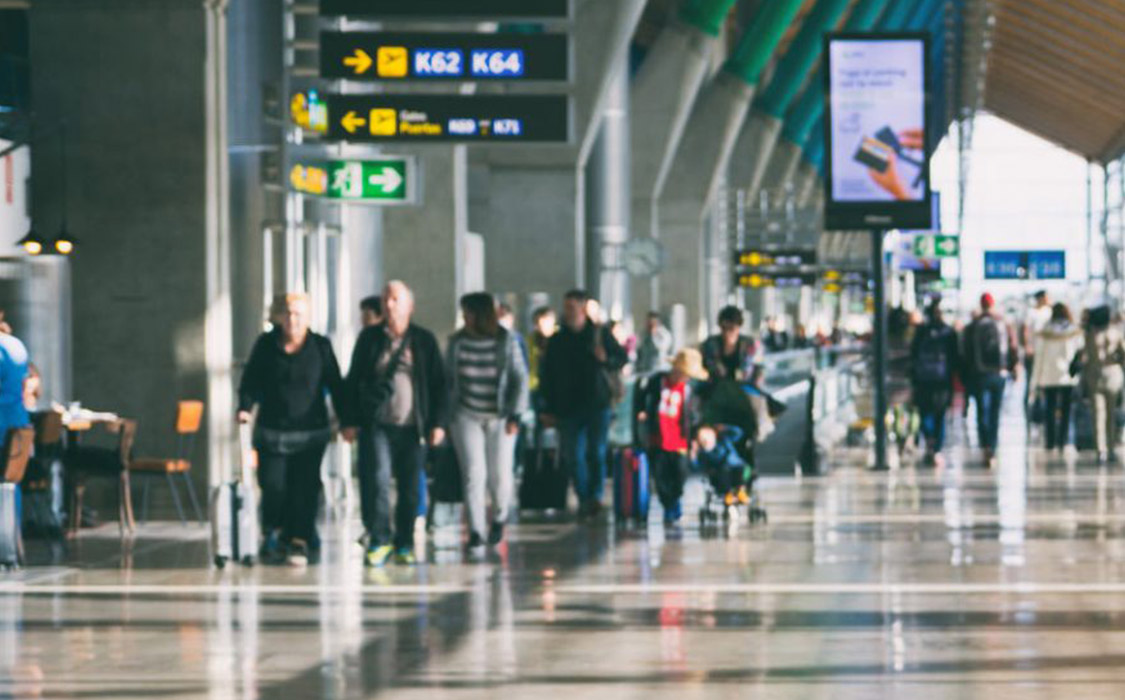Technology Trends

Ultra WideBand Indoor Positioning (UWB Positioning) is one of the most recent emerging indoor positioning technologies. UWB Positioning, supersedes base-band, impulse and carrier-free technology. The United States of America Department of Defense was the first to use the term “ultra wideband”. UWB indoor positioning became commercially available in the late 1990s. UWB radio is a spectrum access method that can provide high-speed data rate communication over the personal area network space.
According to the Federal Communications Commission, UWB positioning is defined as an RF signal that occupies a portion of the frequency spectrum that is greater than 20% of the center carrier frequency or has a bandwidth greater than 500 MHz.
UWB is a communication channel that spreads information out over a wide portion of the frequency spectrum. This allows UWB positioning transmitters to transmit large amounts of data while consuming little transmit energy. UWB location tracking uses the time difference of arrival (TDOA) or the RF signals to obtain the distance between the reference point and the target.


UWB positioning systems rely on transmitting extremely short pulses and use techniques that cause a spreading of the radio energy (over a wide frequency band) with a very low power spectral density. This high bandwidth offers high data throughput for communication. The low frequency of UWB pulses enables the signal to effectively pass through common objects such as falls, furniture and other objects.
How Does Ultra Wideband (UWB) Indoor Positioning Work?
UWB gives a sixth sense to your devices. These signals work on a spatial scale ranging from NANO to Personal Area Networks (PAN). UWB, by design, operates nearby and over a wide bandwidth due to its low pass spectral density. The UWB adheres to the 802.16.5 standard and communicates with peer devices.
The UWB employs pulse radio to transmit a large bandwidth in short cycles while consuming very little power. UWB uses high pulse repetition rates to increase localization accuracy and data rates by transmitting more pulses per second.
The reduction of pulse repetition rates improves ranging performance, making the technology suitable for radars and imaging.
Localization with UWB
Rather than the received signal strength indicator, the measurements are based on Time of Flight (ToF) and Angle of Arrival (AoA) (RSSI). To improve trilateration accuracy, three or more receivers are necessary, but the line of sight is more vital. While ultra wideband location tracking (UWB) tags, they emit pulses containing ID, ToF and timestamp data. Nearby nodes detect and forward signal data to the tracking source for processing. ToF measurements help determine the distance and orientation of tags within a few centimetres.
There are three main areas of use for localization:
- Communication and sensors
- Positioning and asset tracking
- Radar
UWB positioning techniques can give real-time indoor precision tracking for many applications such as mobile inventory and locator beacons for emergency services, indoor navigation for blind and visually impaired people, tracking of people or instruments and military reconnaissance. UWB position tracking signals provide accurate position and location estimation for indoor environments.
UWB provides a high accuracy rate that can minimize error to sub-centimetres. Therefore, UWB positioning is easily one of the most suitable choices for critical positioning applications that require highly accurate results.
Technical Features of Ultra-Wideband
The above example shows how the spectral density of UWB fares compared to other short-range communication protocols. UWB stands out due to its high bandwidth of 500Mhz. It operates efficiently in a signal-dense environment with almost no interference. It performs at frequencies ranging from 3.1 to 10.6 GHz and requires transmission power ranging from 0.5mW to 41.3 dBm/MHz. Within a 10-meter radius, UWB signals have an effective line of sight range of 10-150m and a high data rate of 1Gbit/s.
Ultra Wide Band consumes low power in comparison with other positioning systems that enable power efficiency for better battery life of devices. UWB localization uses pulses that allow transmitters to send only during the pulse transmission which in turn produces a strict duty cycle on the radio to minimize the baseline power consumption.
Why has Ultra Wideband Indoor Positioning Gained Attention Recently?

In general, the high data rate of UWB positioning systems can reach 100 Megabits per second (Mbps), which makes it a great solution for near-field data transmission.
Also, the high bandwidth and extremely short pulse waveforms help in reducing the effect of multipath interference and facilitate the determination of TOA for burst transmission between the transmitter and corresponding receiver, which makes an indoor positioning system using UWB than other technologies.
The length of a single pulse determines the minimum differential path delay while the period pulse determines the maximum observable multipath delay to unambiguously perform multipath resolution.
In addition, the low frequency of UWB pulses enables the signal to effectively pass through obstacles such as walls and objects which improves the UWB positioning accuracy. UWB provides a high accuracy rate that can minimize error to sub-centimetres. Therefore, UWB positioning is easily one of the most suitable choices for critical positioning applications that require highly accurate results.
Due to the increase in market demand, other companies, such as Mapsted, are starting to explore new opportunities in this new market to leverage the advantages of UWB technology in providing more innovative solutions.
UWB vs Other Positioning Technologies
UWB indoor localization technology, unlike other positioning technologies such as infrared and ultrasound sensors, does not require a line of sight and is unhindered by other communication devices or external noise due to its high bandwidth and signal modulation. Also, the cost of UWB equipment isn’t as expensive and consumers have less power than other comparable technologies such as beacons.
Breakthrough in indoor positioning systems is the reason why today we have many commercial implementations of UWB technology. One well-known positioning system example is the Ubisense system. In a Ubisense system, a user carries tags that transmit UWB signals to fixed sensors that use the signals to determine the user’s positions using the time of arrival (TOA) method.
According to a report published by TechNavio market research company, the market for indoor positioning services grew at a compound annual growth rate of 29.7% over the period between 2014 to 2019.
Indoor positioning systems today, in 2022, are powering experience in hospitals, shopping malls, airports, museums, athlete training and others. Due to the increase in market demand, other companies, such as Mapsted are starting to explore new opportunities in this new market to leverage the advantages of UWB technology in providing more innovative solutions.
Legal Concerns with UWB Indoor Localization
While UWB indoor localization does have its advantages, UWB applications must limit their operation to short ranges of frequencies with a wide frequency range of UWB to reduce the probability of interference. For regulating the use of the wide range of UWB indoor localization, there are license-exempt (unlicensed) and individually licensed frameworks. Many countries and administrations have adopted license-exempt frameworks for UWB positioning such as the United States, European Union and many Asia-Pacific countries. These frameworks require the application of special masks and operational conditions. The Federal Communications Commission, European countries, Korea and Japan are aligned in having the entirety or parts of the 3100 to 10,600 MHz band for such extensive applications.
In the United States, there are very strict requirements for the bandwidth and power spectral density of UWB positioning systems. The National Telecommunications and Information Administration (NTIA) regulates the transmission frequencies.
One of the challenges of UWB directional positioning system implementation is avoiding transmission of the signals outside the spectrum. Many countries do not provide UWB frequency allocation for a new device unless it achieves the NTIA guidelines on spectrum complaints or any equivalent requirements in other developed countries.
Strengths of Ultra Wideband Indoor Positioning

License-free
One advantage of using a UWB indoor navigation system is that it is license-free because of its low power. UWB is not classified as radio equipment. Why? Because its low-power signal does not interfere with most of the existing radio systems.
Low Power Consumption
Ultra Wide Band consumes low power in comparison with other positioning systems that enable power efficiency for better battery life of devices. UWB localization uses pulses that allow transmitters to send only during the pulse transmission which in turn produces a strict duty cycle on the radio to minimize the baseline power consumption.
Also, the complexity of ultra-wideband localization communication is more significant at the receiver than at the transmitter. This feature offers low power consumption for senders and shifts complexity as much as possible to the receiver. In addition, UWB has a very high level of multipath resolution because of its large bandwidth.
Large bandwidth
Large bandwidth provides frequency diversity that makes time-modulated ultra-wideband (TM-UWB) signals resistant to multipath problems and interference. Time-modulated UWB has a low probability of interception and detection. Therefore its use is more prominent in military applications.
Unhindered by obstacles
UWB for indoor positioning systems penetrate better through obstacles (such as walls, furniture and people) than conventional signals and they achieve the same data rate. However, due to power restrictions, common UWB positioning systems may face difficulty in penetrating walls.
UWB transmissions involve very short pulses, which have recently received significant interest. Very short pulses offer an advantage in terms of the resolvability of multipath components. Many received signals in an environment that are multipath and are a superposition of the delayed replicas of the signal.
The reflections from objects and surfaces near the path between the transmitter and receiver tend not to overlap in time because of the very short pulses of UWB. This means UWB has a desirable direct resolvability of direct multipath components.
Ultra Wideband Indoor Positioning Weaknesses

Although UWB localization systems have their strengths for many applications, it does have some weaknesses. For example, the possibility of interference with nearby systems that operate in the ultra-wide spectrum due to misconfiguration. In the United States, the UWB frequency range for communication applications is 3.1 to 10.6 GHz, which operates at the same frequencies as popular communication products such as Worldwide Interoperability for Microwave Access (WiMAX) and digital TV. In some countries, it may also interfere with systems such as third-generation 3G wireless systems.
There are some concerns that many UWB positioning devices may cause harmful interference to GPS and aircraft navigation radio equipment. To overcome those concerns, various techniques eliminate harmful interference with other sensitive services, such as Detection and Avoidance.
Interference may also occur from the existing system to the UWB positioning system. The UWB indoor positioning system’s signals may spread over other bandwidths that contain the existing frequency of a narrowband system. This interference can be elevated by using minimum mean-square error (MMSE) multiuser detection schemes to reject strong narrowband interference. Also, simultaneous ranging among many UWB tags may cause some problems with channel access control. This often leads to weakened UWB positioning accuracy.
Although using very short pulses in UWB has many advantages, the UWB receiver requires signal acquisition, synchronization and tracking. It is to be done with very high precision in time relative to the pulse rate. These steps are time-consuming.
Positioning is one of the most important and challenging phases in navigation systems. It is where different technologies have been developed to improve performance.
What’s Better than UWB?
While UWB positioning provides high accuracy positioning in addition to many other features (E.g., license-free, low power consumption does not interfere with most of the existing radio systems, large bandwidth and high data rate communication), UWB positioning technology may affect GPS and aircraft navigation radio equipment and can also cause interference to the existing systems that operate in the ultra-wide spectrum. In comparison to other technologies Mapsted has analyzed, UWB tracking systems have emerged as one of the leading technologies for indoor positioning and have been used in a plethora of applications. Mapsted uses a revolutionary algorithm to leverage a variety of positioning systems and provide the world with the only indoor positioning system that doesn’t rely on the use of Bluetooth beacons, WiFI or UWB signals.
How is UWB Different From Other Positioning Technologies?
To answer the question of ‘how does UWB positioning work’, let’s look at how it contrasts with GPS. Today, indoor positioning technology is almost a curiosity due to its use in a wide range of military and civilian applications. While GPS is synonymous with UWB outdoor positioning and navigation, indoor navigation presents a unique set of challenges that most other technologies have yet to address. That is precisely why the emphasis has shifted to UWB. Whereas traditional short-range communication protocols have flatlined, UWB has remained consistent and adaptive. While immovable obstacles, people and other signal interferences reduce Bluetooth and Wifi range and data rate, they do not affect UWB devices or their ability to perform trilateration on indoor objects and that sets UWB apart from any positioning technology known today.
Concluding Thoughts
UWB transmissions involve very short pulses, which have recently received significant interest. Very short pulses offer an advantage in terms of the resolvability of multipath components. Many received signals in an environment that are multipath and are a superposition of the delayed replicas of the signal. Ultra Wide Band may be appealing due to its distinct advantages over Bluetooth Low Energy and Wi-Fi. However, despite garnering support for its ability to deliver accurate location, they are still unable to do so without hardware. It is critical to deploy three receivers for high precision. Also, because Ultra Wide Band relies on line-of-sight signals, it lags behind an even more advanced solution such as Mapsted’s Indoor Navigation. This is a technology that can outperform UWB in every way to become the world’s best indoor positioning system. That is not what we are saying, but what our clients are. Get a free demo today if you want an exclusive look at our technology.
Frequently Asked Questions
Q1. How does UWB location technology work?
Ans. During UWB transmission, closely spaced pulses are broadcast across a broad spectrum and these pulses are parsed in the exact order in which they were transmitted at the receiver station. For ranging, Time of Flight measurements are used and the accuracy is within centimetres rather than meters as with other positioning technologies. This is why an ultra-wideband location system is a better choice.
Q2. What is UWB used for?
Ans. The UWB localization excels over other similar technologies because it helps in enforcing social distancing by warning tag bearers when they are closer to peer devices. The technology can also unlock and lock doors that are entirely immune to signal spoofing attacks. UWB technology is found in newer Apple gadgets to securely share data with nearby devices.
Q3. Does UWB interfere with Wi-Fi?
Ans. UWB devices can operate effectively in a signal jungle without becoming susceptible to interference or interfering with other narrowband signals operating at the same or nearby frequencies.
Q4. How secure is UWB?
Ans. UWB technology employs robust security protocols that discourage hackers from employing signal spoofing techniques. The technology is at the pinnacle of precise positioning and provides fine-ranging measurements, increasing its efficiency in indoor localization.
Q5. Are UWB systems expensive?
Ans. The cost of implementing a UWB system can be several times that of BLE and Wi-Fi systems. They require specialized tags and peer devices that can send short-range pulses without being power-starved.
Q6. How does UWB work and differ from RFID for asset tracking?
Ans. RFID is commonly used for inventory tracking with passive or active tags, while UWB tracking provides real-time, high-precision location data by measuring signal time-of-flight. Unlike RFID, UWB does not require line-of-sight and offers better accuracy for dynamic environments.
Q7. What is the range of UWB tracking technology?
Ans. The effective range of ultra wideband tracking varies based on the setup and environment. In open spaces, UWB can track objects up to 100 meters, but in indoor environments with obstacles, the range may be reduced to 10-50 meters while maintaining high accuracy.
Q8. Does UWB require an internet connection to function?
Ans. No, UWB tracking does not depend on an internet connection. It operates on a dedicated radio frequency and uses direct communication between UWB anchors and tags. However, for cloud-based analytics or remote monitoring, internet connectivity may be required.
Q9. Can UWB tracking work in environments with metal or concrete structures?
Ans. Yes, UWB signals can penetrate obstacles better than traditional RF-based systems like Bluetooth or Wi-Fi. However, excessive metal surfaces may cause reflections, which can slightly impact accuracy. Proper placement of UWB anchors can mitigate this issue.
Q10. Is UWB tracking safe for human exposure?
Ans. Yes, UWB operates at very low power levels (typically below -41.3 dBm/MHz), making it completely safe for humans and electronic devices. It emits less radiation than mobile phones or Wi-Fi routers.
Q11. What is UWB tracking?
Ans. UWB tracking is a high-precision location technology that uses short, low-power radio pulses across a wide frequency spectrum to determine the position of objects or people with high accuracy.
